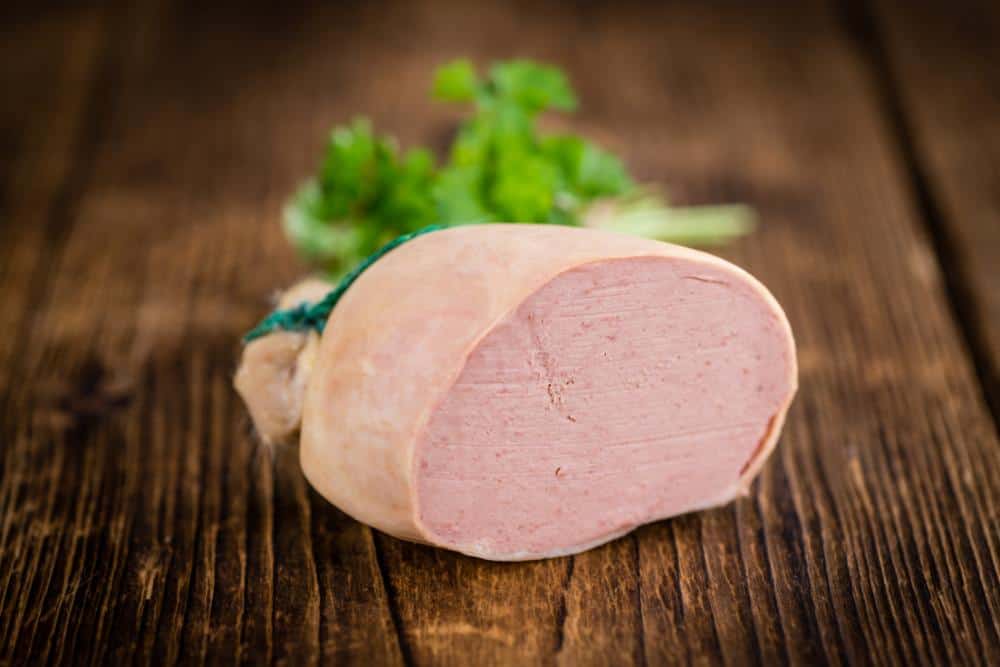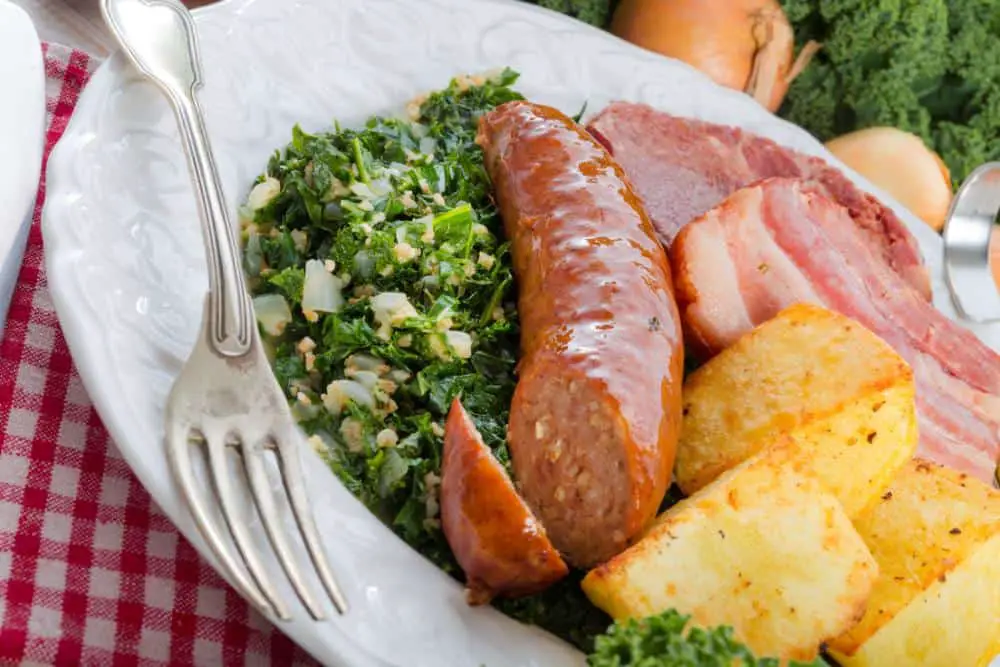Sausages may have their roots in ancient Greece as referenced in The Odyssey, but Germany surely has a strong association with them. German food culture is incomplete without sausages. In fact, the best cured sausages originate from the colder regions of the world, including Germany.
There are over 1000 types of German sausages, and some of them have been around for centuries. One of the most famous historic tales involves a German man named Hans Stromer and 28,000 bratwursts. Stromer was in jail in the 16th century, reportedly eating 28,000 sausages.
Another tale that confirms that Germans have always had a huge appetite for sausages is that of Karl Sterzing. It’s said that he grilled over 2 million sausages from 1945 to 1985.
Over the centuries, Germany introduced the world to many forms of sausages, which led to more than a thousand varieties.
Let’s review the most popular types of German sausages available in select German delis in this article!
Types of German Sausages
Bratwurst
Bratwurst is the most popular type of German sausage. Brat means “without waste,” and wurst means “sausage.” This type of sausage is made of chopped meat, which is either pork, beef, veal, or a combination of these German meats. Bratwurst is mostly grilled.
There are more than 40 varieties of Bratwurst in Germany, and each variety differs based on its region and locality. It’s a staple of the food streets in Germany.
Weißwurst
Weißwurst means “white sausage” in German. It’s among the most popular options for breakfast in Germany. Weißwurst is a Bavarian sausage made of minced bacon, veal, and pork back. The sausage is flavored with parsley, lemon zest, onions, ginger, mace, and cardamon. However, the flavor varies in different varieties of Weißwurst.
This sausage is boiled for 10 minutes before serving, and it’s served with boiling water in a bowl so that it does not cool down. It takes 10 minutes for Weißwurst to turn to greyish-white, which indicates that the sausage is ready to be served.
Blutwurst
Blut means “blood,” and wurst means “sausage” in the German language. Blutwurst is made of lean meat, bacon, lard, tongue, and offal from beef or pork. The chunks of these meats are cooked in rind and fresh blood.
It’s a sliceable cooked sausage with many names, including Flönz, Thüringer Rotwurst, and Grützwurst. To add flavor to the meat, Blutwurst is made more delicious with cinnamon, thyme, marjoram, and cloves.

Frankfurter Würstchen
It’s the Frankfurt sausage which is made of thin parboiled sausage prepared in the sheep’s intestine casing. Frankfurter Würstchen originated in 1592 in Frankfurt. These sausages were served to King Maximilian at his coronation.
Finely minced pork is used to make these sausages; once they are prepared, they are cold-smoked. Using a vacuum-sealed glass, Frankfurter Würstchen is prepared to keep it shelf stable.
Bierwurst
It’s a type of smoked German sausage that originates from Bavaria. Bierwurst is dark red in color with a strong garlicky taste. The seasonings make it more delicious, adding the flavor of black peppercorns, paprika, and mustard seeds to the meat.
The first step of preparing Bierwurst is to cure the meat and then mix it with all other ingredients. As soon as it’s done, the cured meat is rolled into sausages. The next step is to cure it again and smoke and blanch it to complete the process.
Kochwurst
Kochwurst means cooked sausage. It’s a type of sausage prepared using pre-cooked ingredients. The ingredients are mixed together using gelatin-solidified fat, or heated blood proteins turned into a coagulated form.
Kochwurst is made of liver or tongue, blood, and cereal. These sausages are solid, but once they heat up, they become liquefied. Given its texture, Kochwurst is packaged in jars, tins, or intestines.
Wollwurst
It’s a type of sweet sausage made of pork and veal, Wollwurst has many names, but some of the most popular ones are Geschwollene, Nackerte, Oberländer, and Geschlagene. The sausages can be compared to Weißwurst as they are much thinner and longer in size.
The recipe is also similar to Weißwurst, but in Wollwurst, less pork rind is used. It’s also free of parsley. To prepare Weißwurst, you need to dip the sausage into hot water and boil it for 10 minutes.
Leberwurst
Leberwurst is more commonly known as Liverwurst which means liver sausage. The sausage has various forms and flavors, just like many other popular German sausages. Despite the various flavors, all varieties of Leberwurst contain at least 10% liver—some even have 25% liver as meat.
Varieties of Leberwurst include Braunschweiger (blood sausage + liver sausage), Pfälzer Hausmacher Leberwurst (Palatinate liver sausage), and Kalbsleberwurst (veal liver sausage).

Jagdwurst
Jagdwurst literally means hunting sausage. It’s made of lean pork, finely ground pork sausage meat , and pieces of pork belly. Some recipes of Jagdwurst have beef included with the other meat ingredients. The spices added to the meat of Jagdwurst are salt, mace, coriander, ginger, and green peppercorns.
Jagdwurst is best served hot with soup and cold with sandwiches. In eastern Germany, people often layer Jagdwurst with bread crumbs.
Gelbwurst
Gelbwurst is another sausage type that hails from Bavaria, Germany. It’s called yellow sausage, which was invented in 1905. Gelbwurst is made of pork, veal, and seasonings, such as ginger and nutmeg.
Initially, Gelbwurst was made using brains, but modern recipes are different. If a Gelbwurst recipe includes brain, it’s called Hirnwurst or ‘brain sausage.’ Gelbwurst is best enjoyed cold on a bread slice.
Extrawurst
It’s an Austrian sausage type made of beef, bacon fat, and pork. It’s well seasoned to form scalded cold cuts that are light in color, fine in texture, and usually moist. If you want to understand it better, Extrawurst is similar to bologna sausage.
Gurkerlextra is a type of Extrawurst that has small pieces of pickled cucumbers. Another type of Extra wurst is Pikantwurst, which contains chopped red and green peppers.
Ahle Wurst
Ahle Wurst means ‘old sausage.’ It’s another type of German sausage that’s also called hard-pork sausage. It’s made of pork meat and bacon, seasoned with salt, peppers, and other seasonings, including pepper, cumin, sugar, garlic, nutmeg, cloves, and brandy/rum.
Ahle Wurst is smoked or air-dried before serving. Long ago, people used to only process heavy pigs and used their meat, but now, the recipes are modified, yet still delicious.
Pinkel
Hailing from Northwest Germany, Pinkel is a different type of sausage than other popular sausages. It’s a smoked sausage made of pig lard, beef, bacon, barley or oats, and spices. The most common spices used in Pinkel are salt, pepper, and onions. Pinkel is served with pork belly and kale stew as a dish called Grünkohl mit Pinkel.

Teewurst
Another popular German sausage is Teewurst which is made of raw pork and beef. Sometimes beef replaces raw pork in the recipe. There’s one part of bacon and two parts of raw pork in this recipe.
Teewurst was invented in the mid-19th century, and it eventually became a delectable German cuisine. It’s also popular as a spreadable sausage. The ingredients of Teewurst are finely minced before seasoning. It’s packed into artificial casings that are later removed.
Regensburger Wurst
In the late 19th century, this German sausage was invented in Regensburg. It contains fine pork fillings that are shaped into sausages. The recipe for Regensburger Wurst does not contain fat and is spiced using salt and other spices.
The sausages are also smoked before they are boiled. You can either serve them cold or hot, depending on your preference. The most popular dish that contains Regensburger Wurst is Regensburger Semmel. It has the sausage that’s served with a bread roll, pickled gherkin, horseradish, and sweet mustard.
The Ultimate German Food Tour – Schnitzel and Sausage in Munich, Germany!
If you have one day to eat, this German food tour of Munich will give you some serious satisfaction. Going to multiple back-to-back restaurants to eat German food is a challenge – German food is so hearty and so filling. By the end of this food tour in Munich, you will be ready to sleep immediately!
Summary
This German sausage guide highlights the best and most delicious varieties of German sausages. You must have heard of some of them before, but most types would be unfamiliar to anyone who hasn’t tried authentic German sausages.
With over 1000 sausage varieties, Germany has the best selection of sausages. Although Bratwurst, Weißwurst, and Leberwurst are among the most popular sausages, you should give the others a try too at your local deli!
German Sausage Guide – Frequently Asked Questions (FAQs)
Which German Sausage Is the best?
The best German sausage is Bratwurst, which has now become a staple in the food streets of Germany. The iconic sausage is made of a mix of meats, including beef, veal, and/or pork. It’s best paired with horseradish, Sauerkraut, and mustard.
What Is a Large German Sausage Called?
Bratwurst is a large German sausage that has wide varieties. In Germany, the way Bratwurst is served changes from region to region, but mustard and Sauerkraut remain the most popular side dishes.
What Is the Best Way to Cook German Sausages?
The best way to cook a German sausage is to simmer sausages for around 10 or 15 minutes before brushing them with olive oil and grilling them until the skin is crispy and brown.
My name is Jay and I started this website to share my love of Deli Food. I am Jewish with Italian ancestry and grandparents who emigrated to the US from Poland, Russia and Turkey. This website is my celebration of the delicious flavors of international deli culture. Please feel free to send me your suggestions and feedback through the contact form.

